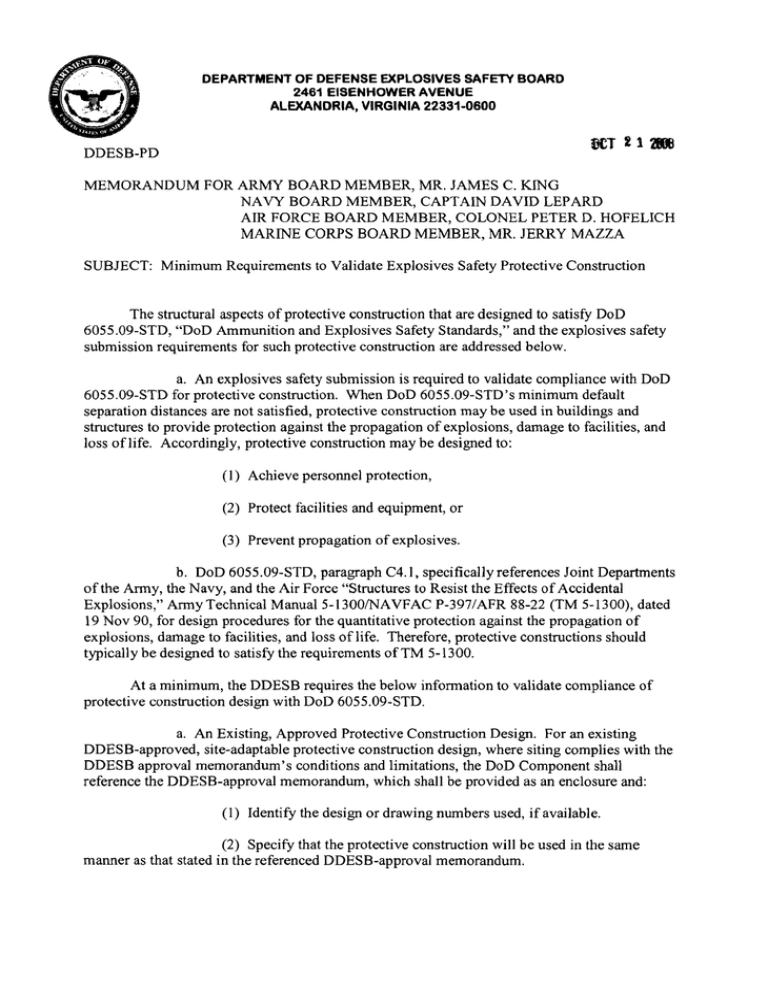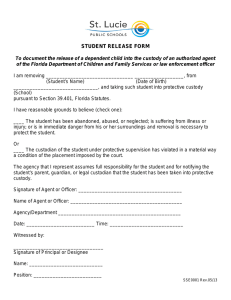Document 12055768
advertisement

DEPARTMENT OF DEFENSE EXPLOSIVES SAFETY BOARD 2461 EISENHOWER AVENUE ALEXANDRIA, VIRGINIA 22331-0600 OCT Z 1 _ DDESB-PD MEMORANDUM FOR ARMY BOARD MEMBER, MR. JAMES C. KING NAVY BOARD MEMBER, CAPTAIN DAVID LEPARD AIR FORCE BOARD MEMBER, COLONEL PETER D. HOFELICH MARINE CORPS BOARD MEMBER, MR. JERRY MAZZA SUBJECT: Minimum Requirements to Validate Explosives Safety Protective Construction The structural aspects of protective construction that are designed to satisfy DoD 6055.09-STD, "DoD Ammunition and Explosives Safety Standards," and the explosives safety submission requirements for such protective construction are addressed below. a. An explosives safety submission is required to validate compliance with DoD 6055.09-STD for protective construction. When DoD 6055.09-STD's minimum default separation distances are not satisfied, protective construction may be used in buildings and structures to provide protection against the propagation of explosions, damage to facilities, and loss oflife. Accordingly, protective construction may be designed to: (1) Achieve personnel protection, (2) Protect facilities and equipment, or (3) Prevent propagation of explosives. b. DoD 6055.09-STD, paragraph C4.l, specifically references Joint Departments of the Army, the Navy, and the Air Force "Structures to Resist the Effects of Accidental Explosions," Army Technical Manua15-l300fNAVFAC P-397/AFR 88-22 (TM 5-1300), dated 19 Nov 90, for design procedures for the quantitative protection against the propagation of explosions, damage to facilities, and loss of life. Therefore, protective constructions should typically be designed to satisfy the requirements ofTM 5-1300. At a minimum, the DDESB requires the below information to validate compliance of protective construction design with DoD 6055.09-STD. a. An Existing, Approved Protective Construction Design. For an existing DDESB-approved, site-adaptable protective construction design, where siting complies with the DDESB approval memorandum's conditions and limitations, the DoD Component shall reference the DDESB-approval memorandum, which shall be provided as an enclosure and: (l) Identify the design or drawing numbers used, if available. (2) Specify that the protective construction will be used in the same manner as that stated in the referenced DDESB-approval memorandum. 2 (3) State that the structural design has not been altered in any manner that impacts the design's integrity or its ability to provide the required level of protection from the effects of an explosion. (4) State that the site specific adaptations of the design have been reviewed and are appropriate for the site conditions. b. Modification of a Previously Approved Protective Construction Design. For a protective construction design previously approved by DDESB, where a structural aspect of the protective design has been modified by a structural engineer with experience in designing blast resistant structures, the DoD Component shall provide: (1) A complete description of the structural modifications made, the reasons for such modifications, and any explosives safety impact resulting from the modifications made. (2) The basis of design and the explosives safety protection being afforded by the modified design. (3) The following protective construction design and DoD Component review data: (a) For preliminary DDESB approval, concept structural design drawings that are at least 35 percent complete must be submitted for review. For final DDESB approval, the structural design drawings must be at a minimum of 60 percent complete, with all protective construction design modifications sufficiently developed for validation. (b) Design calculations for all critical structural elements. (c) All applicable electrical, grounding and lightning protection details. (d) Supporting blast analyses, experimental data reports, blast design calculations, and other pertinent technical information. Blast analyses and design calculations will satisfy TM 5-1300's requirements. (e) A memorandum from the DoD Component's explosives safety office verifying that the protective construction design modifications comply with DoD 6055.09­ STD and TM 5-1300 requirements. This verification will be based upon a quality control review (unless a more detailed independent technical review is warranted based upon either the lack of experience by the designer or the use of a new, unvalidated blast analysis or design approach) by a competent DoD blast design agency, such as the Naval Facilities Engineering Services Center (NAVFAC ESC) or the US Army Engineering and Support Center, Huntsville (USAESCH). Because both of these organizations operate on a cost reimbursable basis, projects must arrange payment for these organizations' services. c. New Protective Construction Design. For a new protective construction design, the DoD Component shall provide: 3 (1) The criteria being met; a complete description of both the design's capabilities and the basis for the design; and the explosives safety protection level it affords. (2) The following protective construction design and DoD Component review data: (a) For DDESB preliminary approval, concept structural design drawings that are at least 35 percent complete must be submitted for review. For final DDESB approval, the structural design drawings must be at a minimum of 60 percent complete, with all protective construction design data sufficiently developed for validation. (b) Design calculations for all critical structural elements. (c) Applicable electrical, grounding and lightning protection details. (d) Supporting blast analyses, experimental data reports, blast design calculations, and other pertinent technical information. Blast analyses and design calculations will satisfy TM 5-1300's requirements. (e) A memorandum from the DoD Component's explosives safety office verifying that the protective construction design complies with DoD 6055.09-STD and TM 5-1300 requirements. This verification will be based upon a quality control review (unless a more detailed independent technical review is warranted based upon either the lack of experience by the designer or the use of a new, unvalidated blast analysis or design approach) by a competent DoD blast design agency, such as the Naval Facilities Engineering Services Center (NAVFAC ESC) or the U.S. Army Engineering and Support Center, Huntsville (USAESCH). Since both of these organizations operate on a cost reimbursable basis, projects must arrange payment for these organizations' services. Once approved, a standard protective construction design can be site-adapted, provided the conditions and limitations of the DDESB approval are met. The DDESB will document new standard approved protective construction designs in DDESB TPI5. Should DDESB criteria for protective construction design change, requiring a higher level of protection, or if subsequent analysis or testing disproves the original design, the DDESB shall notify the respective DoD Component of any increase in risk and such changes will be documented in DDESB TPI5. p~ M. CURTIS Chairman DDESB cc: DDESB Staff BOWLING



